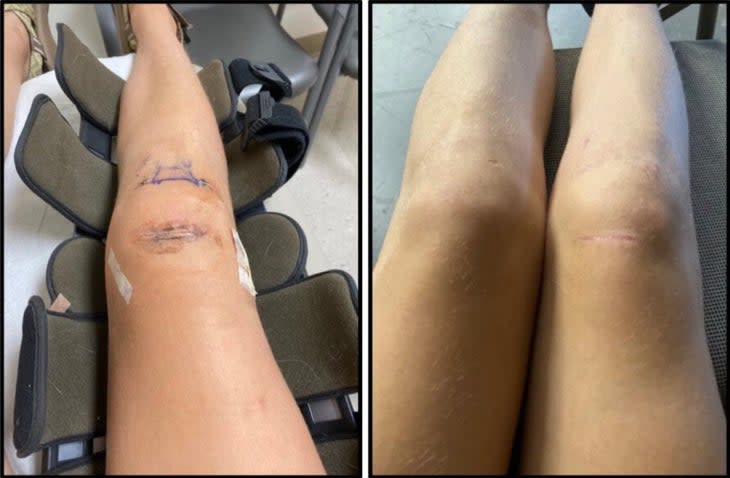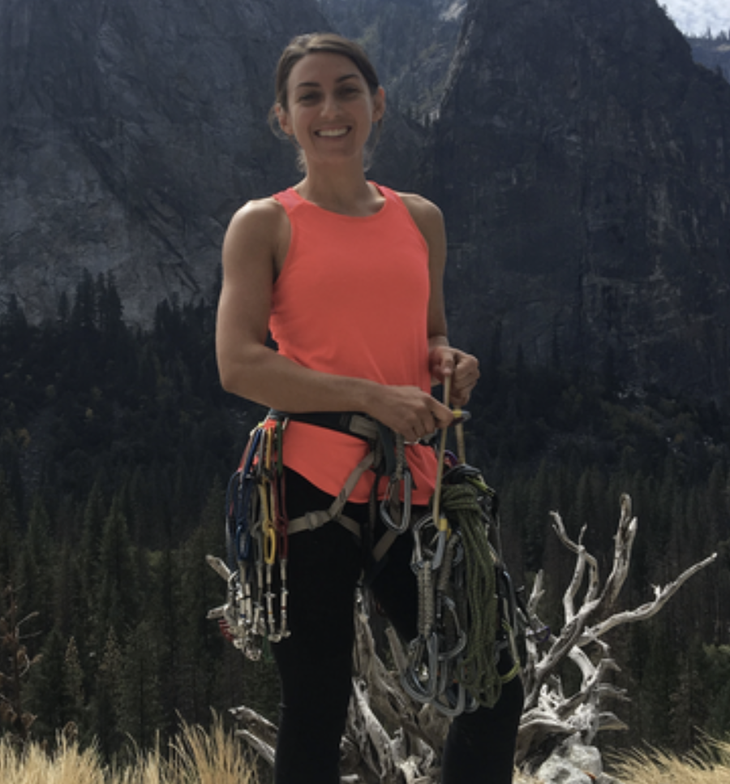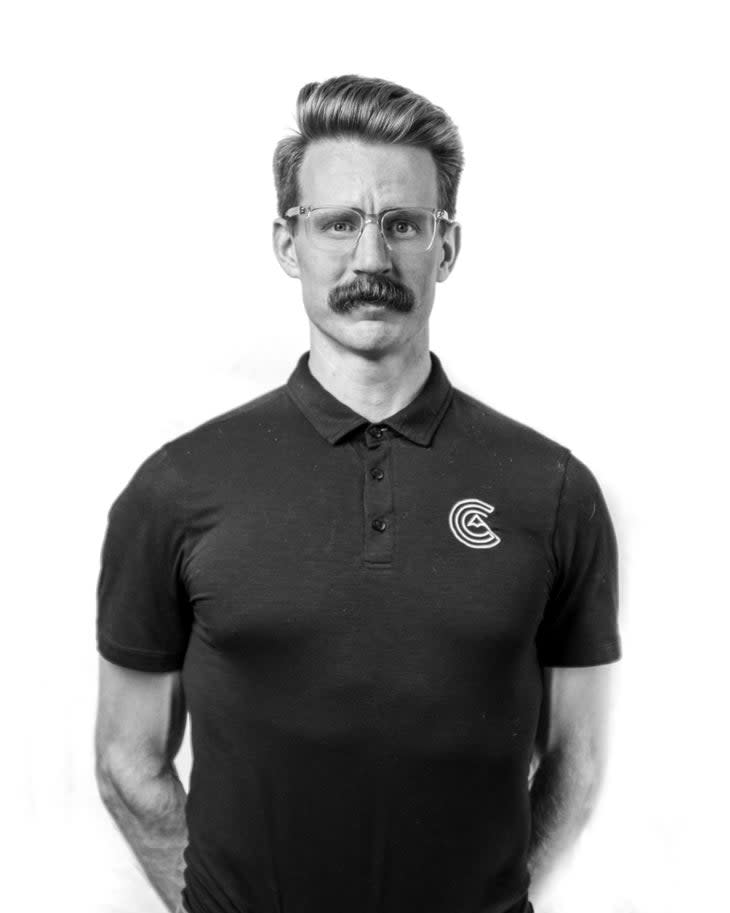How to Return to Climbing After an ACL Tear
This article originally appeared on Climbing
Boost your resilience and climb smarter with this training program geared for injury-free climbing by "The Climbing Doctor," Dr. Jared Vagy. Dr. Vagy will take you through world-class warmups, workouts, and techniques to strengthen your entire body. Enroll today.
You've been training hard, putting in long hours in the gym trying to push into a new grade of climbing. You feel motivated before each session, and eager to throw everything at your project--regardless of fatigue and faltering technique. But as you set up for a crux heel hook, your leg suddenly crumples under your weight with a loud pop!
What just happened?
While the mechanism of injury isn’t yet known, as you stand up one thing is certain: your knee could collapse out from under you at any moment—and it’s swelling fast.
Signs and Symptoms of a Knee Injury
Climbers, particularly climbers who boulder, are at increased risk of knee injury. This can be due to body positioning on the wall or improper falling form which is often associated with fatigue. There are four primary traumatic mechanisms of injury commonly reported among climbers:
High step position
Drop knee position
Heel hook
Uncontrolled fall or unprotected fall
Among these four different mechanisms of injury, ACL tears are the third most common injury, behind medial meniscus tear and IT band sprain, respectively.1 With an ACL tear, patients often report similar sensations such as a shifting sensation (61% of people) and a popping sensation (30% of people). Only 17% of people in this particular study were able to continue with activity immediately following injury, but all reported increased difficulty.2

Assessment
Structure of the knee joint:
Your knee is composed of two joint articulations, (1) the tibiofemoral joint which is the articulation between the femur (thigh bone) and your tibia (shin bone) and (2) the patellofemoral joint which is the articulation between the patella (knee cap) and the femur.
There are several anatomical structures that work to help keep your knee stable. Some of these structures are "active" meaning that it functions by shortening with contractions as we move our bodies. There are other structures that work to keep us stable "passively," meaning that they do not have contractile properties. The anterior cruciate ligament (ACL) is located between the tibiofemoral joint and functions to prevent the tibia and the femur from moving excessively in relation to one another.
Essentially, the ACL works passively to keep your knee stable during everyday activities such as walking, going up/down stairs, and participating in recreational activities including climbing or skiing.

Medical Tests
In order to confirm your diagnosis, your health care provider will likely perform one of the following tests if they are suspecting an ACL tear:
1. The Lachman's Test
These tests can be used to feel for laxity or assess a reproduction of symptoms, like pain. In this test, the examiner provides a rapid anteriorly directed force on your tibia while stabilizing your femur. Without an intact ACL, the examiner may note increased laxity on your involved side when compared to your uninvolved side.
2. Valgus Stress Test of the Knee
Due to the anatomy of your knee joint, commonly, with ACL tears, the medial collateral ligament (MCL) and/or the meniscus can also be involved so this test cab be utilized to rule in or out injury to the MCL. In this test, the examiner will take your knee and push on the lateral aspect of the joint line creating a force directed towards the midline of the body. We call this a valgus force. This test is performed at full knee extension and at 30 degrees of knee flexion to target different fibers within the MCL.
3. McMurray's Test
Similar to the MCL, the menisci are also sometimes injured along with an ACL injury, so this test can be used to rule in or out injury to these structures within your knee. In this test, the examiner will repeatedly bend and straighten your knee while rotating your lower leg. If you've also torn your meniscus, this test may be painful.
If you've torn your ACL, you're likely familiar with many of these tests, whether you know it or not. Your physical therapist or surgeon has likely performed them on you.
You probably also had an MRI11 so that your physicians could confirm the suspected diagnosis visually. Radiologists look for structural abnormalities on the image to determine the cause of the your symptoms.

Maybe you had a partial tear. Maybe yours was complete. Maybe you had reconstruction surgery, maybe you didn't. You may feel overwhelmed, but it is important to realize that you are not alone in this process. There have been climbers in your position before you, and unfortunately there will be climbers in the future too. Whatever path you took and whatever decision you made to start on your journey to recovery, there are some rehab pro-tips you should know if you've torn your ACL and you want to get back to climbing.
Treatment Strategies: The Rock Rehab Pyramid
Below, I have outlined a progression of activities and exercises which may be helpful rehabilitation of a torn ACL. The framework for my ideas is based on The Rock Rehab Pyramid, a self-treatment approach for common climbing injuries designed by physical therapist Dr. Jared Vagy (Instagram: @theclimbingdoctor). For more information, please check out his book, Climb Injury-Free. Any advice presented here is not meant to replace the one-on-one guidance of a medical professional. Perform at your own risk.

Step 1: Unload

1. Bracing
Without the passive stability provided by an intact ACL, you will likely need a brace right after the injury to help keep your knee stable. Often, a functional knee brace is recommended as it can restrict range of motion while allowing specifically tailored range into flexion and extension to give you functional independence.
2. Crutches
You will likely benefit from the assistance of crutches to help you offload the knee.
3. Ice
This will help with to reduce the pain and swelling associated with your injury and will become a vital part of the recovery process in terms of managing your symptoms and regaining mobility.
Step 2: Mobility
1. Extension Range of Motion 3
One of the first things you will want to work on is to regain full knee extension range of motion (ROM) right away. This will allow you to avoid a condition known as a knee flexion contracture. Consider icing your knee with your foot elevated and foot/ankle supported with your knee unsupported. This will allow you to regain range of motion with the help of gravity and can serve as a passive mobility exercise to rely on in the early stages of your recovery.

2. Flexion Range of Motion
Work on regaining knee flexion range of motion. Here are several exercises that you can use right away to help you regain this range of motion early on in your recovery.
3. Soft Tissue Mobilization
Your physical therapist will likely teach you some forms of manual intervention, which can be thought of as targeted massage with the goal of reducing scar tissue which will reduce limitations in mobility.
Step 3: Strength Exercises-Early Recovery Strengthening
It is important to note that quadriceps muscle atrophy is extremely common with ACL injuries and ACL reconstruction surgeries. As a result, strengthening is often aimed at targeting the quadriceps initially. Here are a few ways to start working towards regaining quadriceps strength. These exercises may be beneficial during the first few weeks of your recovery.
1. Quadriceps activation.
Many people report delayed quad activation following ACL reconstruction due to a reflex response called arthrogenic inhibition. This is a common response following a joint injury as it acts as a protective unconscious response.4 However, this often lingers and can impair quadriceps activation into the early stages of the recovery process. The first exercise to consider would be a quad set which is essentially contracting your quadriceps muscle for a sustained period of time. This allows you to retrain your brain that it is safe to turn on these muscles and move the joint again. Place your knee over a towel (or a rolled up empty chalk bag) and push the back of your knee into the towel. Hold for 10 seconds, repeat 10 times.
2. Straight Leg Raise
A straight leg raise is the next level of your quad activation progression. First, perform a quad set and then maintain full knee extension as you lift up your leg to about 60 degrees of hip flexion. You may have trouble keeping your knee completely straight when you first try this exercise. Keep trying. Performing a straight leg raise without letting your knee bend is a huge milestone for people as they recover from their ACL injury.
3. Neuromuscular Electrical Stimulation (NMES)
If you are still having trouble with activation, you could consider utilizing NMES which relies on electrical impulses to assist with motor unit recruitment to assist with the quality of the muscular contraction. In this way, it can be used to help people with weakened quadriceps following an ACL injury and reconstruction. Talk to your physical therapist about the pros and cons of adding this to your recovery plan.5
Step 3: Strength Exercises-Mid Recovery Strengthening
Two to four months post-op, you could begin to consider more advances strengthening opening by increasing the demand you are putting on your body. Here are a few options to do just that.
1. Double Leg Squats (with option to include BFR)
Blood flow restriction therapy, or BFR, is something that can be used to help strengthen at lower loads. The concept behind the blood flow restriction is that with reduced blood flow, the climber is able to perform exercises, such as squats, at lower intensities and achieve greater results. This is useful in climbers post ACL injury due to the weakness of the quadriceps initially. 6
In this video, we will see a climber working through a set of squats. Ask your doctor or physical therapist about the benefits of adding BFR into your personal recovery plan.
2. Hip Abductors Strength
Many studies have shown that hip abductor weakness is correlated with an increased risk of ACL injury.7,8 Therefore, working on hip abductor strength will help to prevent re-injury due to weak hips.
One exercise you can consider would be side stepping with theraband. Go into a squat position and maintain throughout this exercise to target your hip abductors. You'll feel the burn.
3. Standing Clam
Another great exercise for this muscle group is the standing clam. This will help you strengthen throughout your hip internal and external rotation range of motion. Choose the band to best fit your desired challenge based on the stage of your recovery journey.
Step 3: Strength Exercises - Late Recovery Strengthening
As you begin to think about returning to climbing, and the demands of the sport on your body, you want to begin adding in some higher power exercises to best prepare your body. Here are a few examples of fast and explosive exercises to begin adding into your recovery in this stage of your recovery.
1. Plyometrics
Plyometric activities, such as jump squats can allow you to regain power and stability in your limb that will be important for getting you back on the wall. These activities combine traditional strengthening exercises with balance and high velocity training which will help prepare you for those high powered and explosive moves while on the wall.
2. Lateral Jumping
Adding lateral movements to your jumping can be done to add increased difficulty and prepare you for powerful movements and for soft landings. Consider adding this lateral jumping exercise, also known as Speed Skaters, to your program.
Step 4: Movement
When attempting to return to sport, it is important to consider the overall healing trajectory of the ACL. After your surgery, you will likely need to wait about 3-4 months before you are able to top-rope in the gym. If you are primarily a boulderer, you will dust off that harness and get back to climbing with the safety net of the rope. Top-rope climbing will also allow you to regain confidence. Here are a few things to consider:
Avoid high stepping to protect your healing ACL for the first few months back on the wall.
Climbing routes of lower grades will allow you to modify your climbing to fit with your current knee range of motion and strength.
Make sure you trust your belayer. This will help add to your confidence.
If you feel any anxiety related to getting back on the wall after a fall resulting in an ACL tear, consider trying out meditation or other mindfulness activities to help you work through those feelings.9
Typically, athletes are able to return to their pre-injury level of activity within nine months–one year post-op.10 For bouldering, this may take even longer due to the high forces that can be generated from falling or dropping off the route. You will slowly work your way up from lower grade top-rope routes, back to bouldering and sport routes as your strength continues to improve.
As you return to climbing, keep in mind the following principles:
Warm up before you climb with light aerobic exercise and dynamic stretching. This allows you to increase blood flow and loosen up your muscles.
Follow proper form and avoid positions that will put unnecessary stress on your knee initially (such as high step or drop knee positions).
Rest between sessions. This will allow your body to continue healing as you get stronger and more comfortable on the wall.
Get plenty of sleep and drink lots of water.
Remember, you are not alone in this. Unfortunately, there is an ever-increasing number of climbers that have torn their ACL before you and there will be many after. The one silver lining in this is that you are able to lean on your climbing community to receive advice and support as you work toward getting back on the wall. Soon enough you will be back to sending those bouldering routes and pushing to the next grade. Until then, keep working on regaining your strength and range of motion. I look forward to seeing you back in the gym soon. Until then, keep up the stoke.
(Video: Courtesy of Rachel White on her first route four months post right ACL reconstruction surgery)
When to See a Medical Practitioner
If you suspect an ACL injury, you should consider seeing an orthopedic specialist to get imaging (X-rays or MRI) to figure out with is going on. If you decide to have surgery, you should see a physical therapist to help you regain range of motion prior to your operation as this will assist in improving your range of motion and strength before your operation. This will also allow an easier transition into a post-op physical therapy program as you will work on improving strength.


About the Author
Carly Post, SPT, is a third year Doctor of Physical Therapy student at USC in Los Angeles, CA. Carly started climbing during her undergraduate career at the University of Denver in Denver, CO back in 2015. has been climbing on and off ever since! She is now living in Los Angeles, California, and can be found on Instagram @carlypost.
About the Contributors

Dr. Jared Vagy "The Climbing Doctor," is a doctor of physical therapy and an experienced climber, has devoted his career and studies to climbing-related injury prevention, orthopedics, and movement science. He authored the Amazon best-selling book Climb Injury-Free, and is a frequent contributor to Climbing Magazine. He is also a professor at the University of Southern California, an internationally recognized lecturer, and a board-certified orthopedic clinical specialist.
To learn more about Dr. Vagy you can visit theclimbingdoctor.com or visit him on Instagram @theclimbingdoctor

Jennifer Demyanek is a physical therapist, college professor, and rock climber in Las Vegas, Nevada. She is a graduate of the University of Maryland School of Medicine with a Doctorate degree in Physical Therapy. Jennifer is the owner of Onsight Movement, a private physical therapy practice located in Las Vegas, specializing in treating rock climbing injuries and improving climbing performance. She also currently serves as Adjunct Faculty at the College of Southern Nevada teaching Anatomy & Physiology.
Jennifer is an officer of the virtual Rock Climbing Special Interest Group as well as a member of the American Physical Therapy Association's Orthopedic Section. She also holds a certification in Dry Needling from the American Academy of Manipulative Therapy. When not practicing physical therapy, Jennifer can be found outside rock climbing around the southwest or spending time with her husband, Dylan. You can contact Jennifer via email at jennifer@onsightmovement.com or by visiting www.onsightmovement.com.

Kevin Cowell is a physical therapist, clinical instructor, and rock climber based out of Broomfield, CO. Kevin owns and operates The Climb Clinic (located at G1 Climbing + Fitness) where he specializes in rehab and strength training for climbers and mountain athletes. He found his passion for climbing in Colorado while attending Regis University for his Doctorate of Physical Therapy and has since become a Certified Strength & Conditioning Coach (CSCS), Board-Certified Orthopaedic Clinical Specialist (OCS), and a Fellow of the American Academy of Orthopaedic Manual Physical Therapy (FAAOMPT).
You can contact Kevin via email at kevin@theclimbclinic.com or by visiting www.theclimbclinic.com. Also, be sure to follow Kevin at @theclimbclinic on Instagram for free rehab and strength training resources.
References
1. Lutter C, Tisher T, Cooper C, et al. Mechanisms of Acute Injuries in Bouldering and Rock Climbing Athletes. ASJM. 2020; 48(3): 730-8.
2. McNair PJ, Marshall RN, Matheson JA. Important features associated with acute anterior cruciate ligament injury. N Z Med J. 1990;103(901):537-9.
3. Asakawa D, Sakamoto M. Retrospective survey of sport climbing injuries and self-care in the Gunma prefecture. J Phys Ther. 2019; 31: 332-5.
4. Hart JM, Pietrosimone B, Hertel J, Ingersoll CD. Quadriceps activation following knee injuries: a systematic review. Journal of Athletic Training. 2010; 45(1): 87-97.
5. Lynch AD, Logerstedt DS, Axe MJ, Snyder-Mackler L. Quadriceps activation failure after anterior cruciate ligament rupture is not mediated by knee joint effusion. JOSPT. 2012; 43(6): 502- 510.
6. Kilgas MA, Lytle LLM, Drum SN, Elmer SJ. Exercise with blood flow restriction to Improve quadriceps function long after ACL reconstruction. Int J Sports Med. 2019; 40: 650-656.
7. Garrison JC, Bothwell J, Cohen K, Conway J. Effects of hip strengthening on early outcomes following anterior cruciate ligament reconstruction. IJSPT. 2014; 9(2):157-167.
8. Powers CM. The influence of abnormal hip mechanics on knee injury: a biomechanical perspective. JOSPT. 2010; 40(2): 42-51.
9. New York Bone & Joint. Preventing orthopedic injuries from rock climbing or bouldering. https://nyboneandjoint.com/blog/preventing-orthopedic-injuries-from-rock-climbing-or-bouldering/. Accessed [14 February 2022].
10. Mass General Brigham. Rehabilitation protocol for anterior cruciate ligament (ACL) reconstruction. https://www.massgeneral.org/assets/mgh/pdf/orthopaedics/sports-medicine/physical-therapy/rehabilitation-protocol-for-acl.pdf Accessed [26 January 2022].
11. ARA Diagnostic Imaging. Images of what a musculoskeletal radiologist sees. https://www.ausrad.com/images-of-what-a-musculoskeletal-radiologist-sees/. Accessed [18 January 2021].
For exclusive access to all of our fitness, gear, adventure, and travel stories, plus discounts on trips, events, and gear, sign up for Outside+ today.

